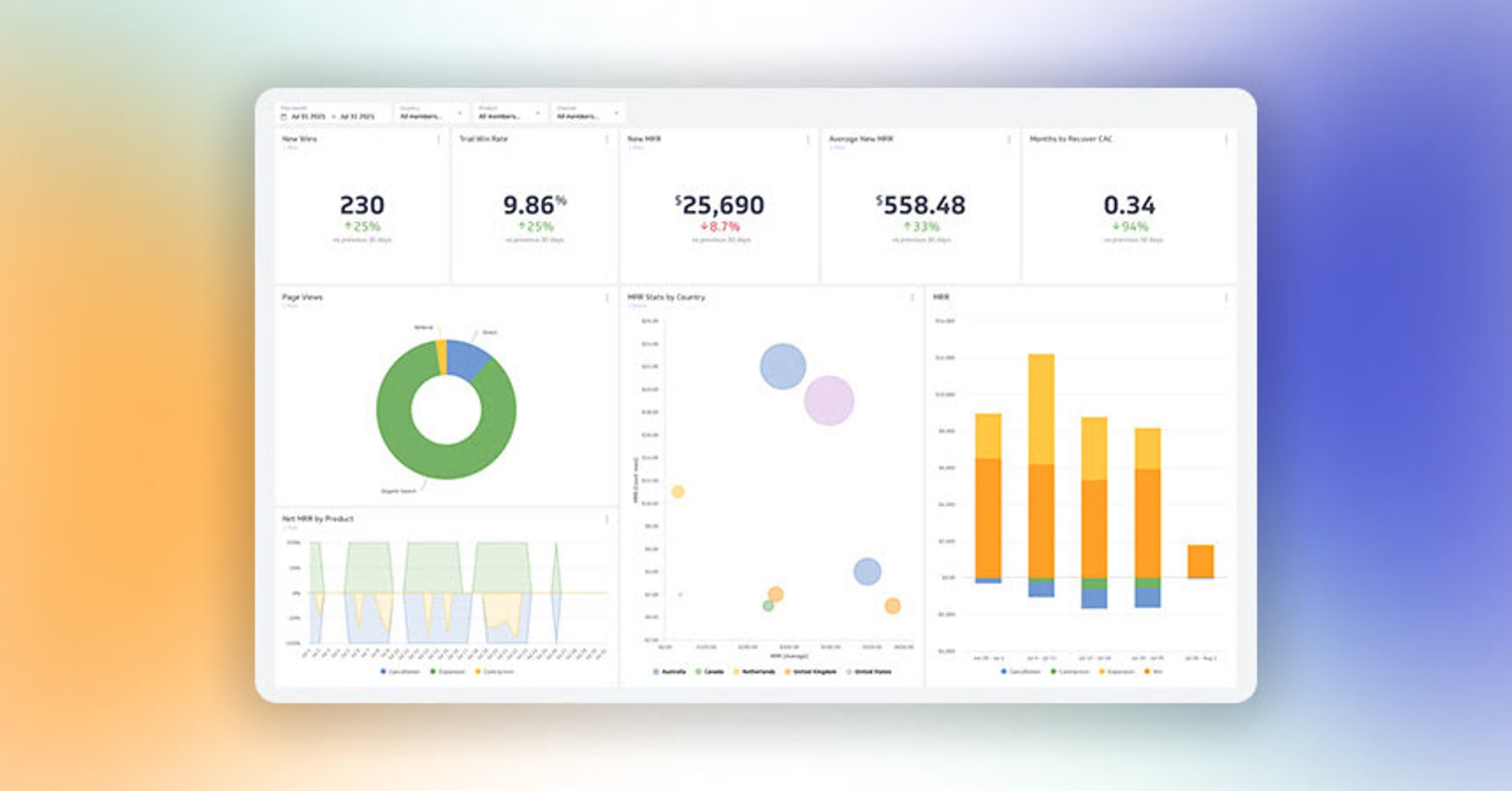The top 10 Twitter analytics metrics you need to track

Published 2023-09-27
Summary - Your Tweeting so now what? Learn what are the most important metrics to track on Twitter.
There are a million different Twitter metrics out there.
But only a few can truly provide what you need to track your progress against your goals.
In this post we’ll look at the top 10 Twitter Analytics metrics that you can use determine how well your Twitter account is performing.
Obviously, you’ll want to tailor these to fit the unique needs of you/your organization.
That’s why we’ve also included related metrics that you can dip into when a given metric doesn’t quite fit what you’re trying to accomplish.
The top 10 Twitter analytics metrics
The top 10 Twitter analytics metrics are:
- Link clickthroughs
- Video views
- Impressions by time of day
- Top tweets
- Conversions
- Demographics
- Top mention
- Like rate
- Hashtag performance
- Followers
Before we get started...
Just like your organization, your metrics should be unique.
Depending on your OKRs and the campaigns you're looking to measure, the widely recognized Twitter KPIs may need a bit of customizing to best fit what you're trying to track.
Metrics are unique to the organizations and campaigns they are measuring.
That’s why, in addition to the main metrics listed here, we’ve also included alternative metrics. That way you can mix and match these to find the ones that will matter most to you.
Now that we have that out of the way, let me present to you the top 10 metrics for Twitter analytics.
Link clickthroughs
What it measures
Link clickthroughs measures the number of times users have clicked through to one of your web pages from Twitter – either from organic posts (i.e. content you’ve posted that has no paid spend behind it) or through paid ads.
The score is measured on a scale of one to 10. A one means your score is barely relevant to your audience. A 10 means it’s very relevant.
Why it matters
Twitter is a great place for helping your website content to reach a wider audience. Growing your following, using hashtags and running some paid ads are all great ways to get more people clicking through to your website.
Alternative and simmilar metrics
- Link shares (by other users)
- Clickthrough rate (CTR)
- Link clickthroughs (organic)
- Link clickthroughs (paid)
Video views
What it measures
Video views measure the number of times users have watched the videos you’ve natively uploaded to Twitter.
A Twitter video view is counted any times two consecutive seconds are played with at least 50 per cent visibility, according to Mashable.
Why it matters
People love to watch videos these days.
That’s why social media channels like Facebook have prioritized videos as part of their algorithm (which decides the content that will appear in a user’s feed).
Twitter isn’t as well-known for creating a great algorithm as some other social media channels.
But it’s still there.
The difference is that, unlike Facebook and Instagram, Twitter allows users to turn off the algorithm and instead see tweets chronologically.
Many users, of course, choose to do so. But many don’t.
And even for those who do choose to see tweets as they appear chronologically there are still features – such as the “In case you missed it” area, which appears on mobile – that highlight top content.
What does it mean for you?
It means that, because Twitter prioritizes video with high engagement levels, you need to find ways to increase engagement.
How do you do that?
By producing video content.
It will increase your following whether your users rely on the algorithm or not.
If you measure which videos are getting the most views you’ll be able to refine your strategy to help produce the best video content that engages your audience.
Alternative and similar metrics
- Completed video views
Impressions by time of day
What it measures
Impressions by time of day measures the time when people are seeing your tweets the most.
(Note: Impressions by time of day is not a metric that Twitter analytics provides directly. Instead, you’ll need to do some fancy footwork to get this into a usable format. For more info, check out this blog post from Buffer).
Why it matters
When are you followers most likely to be on Twitter?
Many Twitter users only see their tweets chronologically.
That means that, if you aren’t tweeting when people are using the platform, you’re likely not going to reach them.
Measuring impressions by time of day helps to tell you when you are most likely to be able to reach your users.
From there, you can start planning the time your posting around these times.
This will help to increase your reach, impressions and – hopefully – engagement.
ALternative and similar metrics
- Most clicks by time of day
Top tweets
What it measures
Top tweets measures the tweets that performed best on your account during a particular time period.
Twitter allows you to break down your top tweets by:
- Impressions
- Engagements
- Engagement rate
Why it matters
Want to know the sorts of content that engages your audience?
Top tweets is a good place to start.
From there you can get a sense for the sorts of tweets that your audience most wants to see and engage with.
What types of content are they most interested in?
Do they prefer tweets with video or image content?
Do tweets with links or without perform better?
These are the sorts of questions you can answer by looking at your top tweets.
Alternative and similar metrics
- Top video tweet
- Top image tweet
Conversions
What it measures
Conversions measures the number of users who have taken a key action on your website, such as making a purchase on an online store or signing up for a newsletter.
Like with many other social media, Twitter offers users a tag that they can install on their website.
From their, they can set up conversion goals that measure key conversion events.
Why it matters
Conversions should be a key focus of your Twitter efforts – particularly if you’re putting a paid spend behind them.
By measuring conversions you can optimize your ad campaigns for key conversion goals and also get a sense for which Twitter content is driving the most action.
Twitter also allows advertisers to set up their campaigns so they are optimized for conversions.
For this, setting up conversion goals is a must.
Alternative and similar metrics
- Cost per acquisition
- Customer lifetime value (CLV)
Demographics metrics
What it measures
Twitter, as with many other social media platforms, provides a ton of metrics related to users’ demographics.
Known as “audience insights” within the Twitter platform, this offers information on your audience’s:
- Interests
- Wireless carrier
- Language
- Location
- Gender
The Twitter ads interface also offers its own set of demographic measurements that can offer insight on which users are engaging with your ad campaigns.
Why it matters
Looking to know more about your audience?
Twitter analytics is a good place to start.
This will give you good insight into who is engaging with your content that can be put to use for designing campaigns both on – and off – Twitter.
Alternative and similar metrics
- Demographic metrics for followers
- All Twitter users’ demographics
- Your organic audience’s demographics
Top follower
What it measures
The top follower metric on Twitter analytics measures the account that followed you during the month with the most followers.
This metric, like the top tweet, top mention and top media tweet metrics, can only be broken down by month.
That means that each month you’ll need to check in to see who was the top follower for each month.
Why it matters
The top follower metric can be a goldmine for influencer marketers.
It can give you a sense for the followers that have demonstrated an interest in your brand.
From there you can try to engage them in helping spread your message, either through an influencer marketing campaign or just in posting and retweeting and your content.
Alternative and similar metrics
- Top mention
Engagement rate
What it measures
Engagement rate on Twitter measures the percentage of users who, after seeing your tweets, engage with them in some way.
An “engagement” can include a wide range of actions, but typical examples include likes, retweets, replies, and clicks.
You can calculate your Twitter engagement rate by dividing your total number of engagements (however you choose to calculate them) for all your tweets over a given time period into the number of impressions those tweets received.
For example: Let’s say in April 2018 your tweets received 50 engagements and 5,000 total impressions.
Dividing 250 (your engagement total) into 5,000 (your impression total) would give you an engagement rate of five per cent.
Why it matters
Gaining followers is one thing.
What you do with them after you get them to follow?
Another matter entirely.
Engagement rate helps give you a sense for how effectively you are engaging your followers.
You can also measure the equivalent of engagement rate for different engagement metrics, such as retweet and like rate.
Alternative and similar metrics
- Like rate
- Reply rate
- Retweet rate
- Engagements
Hashtag performance
What it measures
The number of times hashtags you are closely following were used in tweets (by other users).
Why it matters
Hashtags are a big thing on Twitter.
If you’re running a branded hashtag campaign, tracking them can help give you a sense for how far other Twitter users are spreading them.
But even if you aren’t, there’s still a place for tracking hashtags
Say your organization is interested in education. There will probably be hashtags – a quick search reveals #alwayslearning to be one of interest – you want to follow as well, even if they’re not directly related to campaigns you may be running.
Alternative and similar metrics
- Competitor hashtags
Followers
What it measures
Followers measures the number of users who follow your Twitter account.
Why it matters
Gaining more followers significantly increases the chances that users are going to engage with your content.
It also signals to potential followers that, yes, a significant number of people have decided to start following your account and find continued value in it.
This can be a huge selling point for attracting even more followers.
A note of caution, though: Beware following too many accounts yourself.
This will suggest to users that you only gained your followers by getting other users to follow you back, not through producing quality content.
Alternative and similar metrics
- Reach
And that's it!
I hope this post has helped orient you in the landscape of Twitter Analytics and what the most popular metrics are to monitor for success.
Related Articles

17 KPIs Every Data-Driven Manager Needs to Lead Their Team
By Danielle Poleski — October 14th, 2025
7 ways to present KPIs that your management team will love
By Danielle Poleski — September 25th, 2025
12 Important Sales Enablement Metrics You Shouldn't Miss
By Grace Lau — September 19th, 2025

